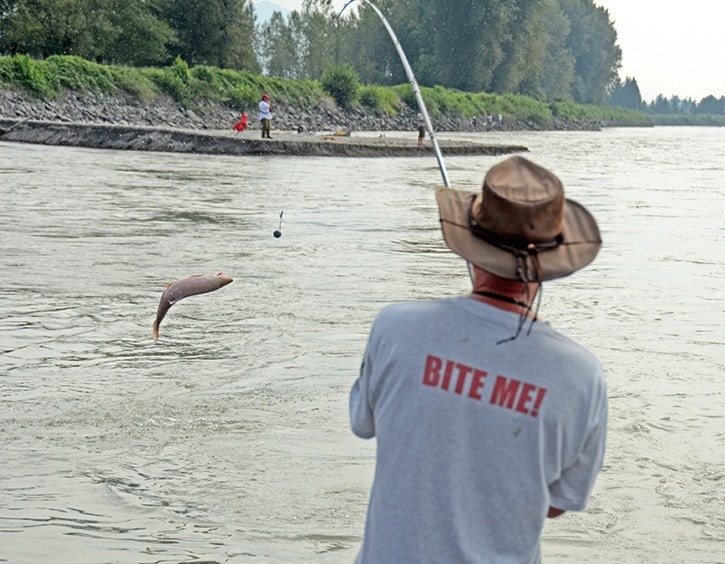One of the great ironies of recreational sockeye fishing in the Fraser River is that in a season of large returns such as this year’s, many “real” anglers stay away.
For sport fishers who hit the waters 12 months of the year, week in week out, rain or shine, the idea is simple: put out a lure of some kind on a hook and try to get a wild fish to bite it.
But what’s going on right now at places like Peg Leg Bar bears no resemblance to true sport fishing, according to many practitioners.
“It’s not sport fishing,” says local recreational fisherman Matthew Hawkins who does equipment reviews and fishing podcasts with his partner Ryan Enns on their website, fishingguys.ca.
“We call it a meat harvest.”
When there are literally millions of sockeye swimming past places like Peg Leg the quadrennial anglers come out of the woodwork and practise a technique known as “bottom bouncing” or “flossing.”
In the muddy waters of the Fraser River, putting bait or wool on a hook is a charade, according to Hawkins.
 The fish can’t see anything. The prized sockeye aren’t biting at lures, drawn to the subtle attractants of the sport fisher. No, the salmon being yanked out of the Fraser River at places such as Peg Leg are often foul-hooked in the belly, the back or the tail.
The fish can’t see anything. The prized sockeye aren’t biting at lures, drawn to the subtle attractants of the sport fisher. No, the salmon being yanked out of the Fraser River at places such as Peg Leg are often foul-hooked in the belly, the back or the tail.
Spend some time on the bar and you’ll see the “beakers” bragging they have a large Chinook on the line.
But there’s a good chance they’ve simply foul-hooked a little sockeye, Hawkins says.
“If you’ve got a five-pound fish in the tail, you feel like it’s a 20-pound fish.”
The flossing technique used is controversial in the fishing community although not illegal. Many sport fishers don’t like it while many simply turn a blind eye.
Fish caught anywhere but in the mouth are supposed to be returned to the water, but Hawkins says many of those even caught in the mouth haven’t actually bit a lure, they just happen to be hooked near the mouth.
“The fish don’t bite in this part of the Fraser,” Hawkins said. “More often than not the hook will be on the outside of the mouth.”
Chris Gadsden is co-founder of the Fraser Valley Salmon Society and he agrees with Hawkins. Gadsden was instrumental in getting sockeye retention allowed on the Fraser River in the 1980s and, in some ways, he feels like he made a mistake. Like Hawkins, Gadsden stays away from the Fraser during this massive sockeye run, and he bemoans the fact that many people are learning to fish by bottom bouncing, a technique they then bring to the Chilliwack/Vedder River and other bodies of water where the water is clear.
Like Hawkins, Gadsden says true sport fishing is the art of trying to lure a wild fish to bite at your hook. What's happening now on the Fraser is just "snagging" and it's a "meat grab," he says.
Despite the controversy, there is one thing true anglers such as Hawkins have in common with the snaggers that line the banks of easy-access bars along the Fraser River in Chilliwack: “There is something about being able to know where your food came from and bring it home; something fresh and wild.”

